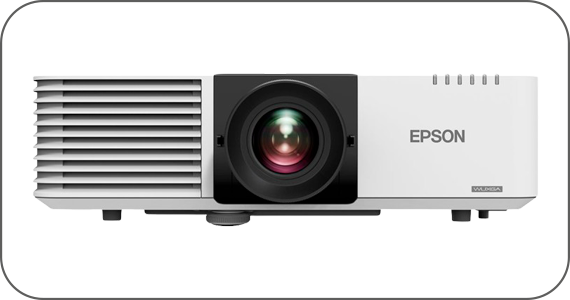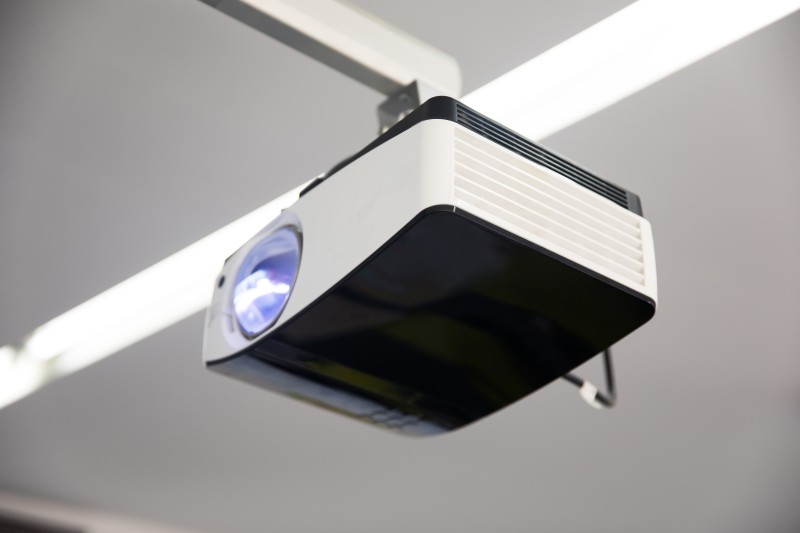- Card printing
- Label printing
- Barcode scanner
- Tablets/handhelds
- Displays/projectors
- RFID technology
- Price labelling
- Point of sale
- Robotics

Projectors
No products found.
Projectors (beamers)
Projectors - also known as beamers - are versatile display devices that can be used to project images, videos or presentations onto a large screen . They are used in a wide variety of applications - for example in professional environments for meetings and conferences, in the education sector for training and teaching units or in the private sector for home cinema.
Modern projectors are available in various technologies , including LCD, DLP and LED. Each technology offers specific advantages in terms of image quality, brightness, contrast equalisation and energy efficiency. The right choice depends on individual requirements, the size of the room and the lighting conditions on site.


Advantages of modern projectors and beamers
Modern Projectors and Projectors offer a variety of technical advantages that make them a powerful solution for a wide range of applications:
- High image quality: The latest projectors deliver razor-sharp images in high resolution - ideal for detailed presentations, videos or texts.
- High flexibility: Can be used almost anywhere - in the conference room, classroom, home cinema or even at outdoor events.
- Large projection surface: A projector can be used to display significantly larger screens than conventional televisions - perfect for large rooms or public events.
- Wide range of connection options: Modern projectors support numerous interfaces (e.g. HDMI, USB, WLAN, Bluetooth) and enable connection to laptops, tablets, smartphones and other devices.
Choosing the right projector
The choice of the rightprojectordepends on the area of application. High-resolutionprojectorswith at leastFull HD, a goodcontrast ratioand highbrightnessare used inhome cinemas- ideal for large images in dark rooms.
Forbusiness applications,portable projectorswith high light output, fastconnection optionsand uncomplicated operation are recommended - perfect for meetings and mobile presentations.User-friendlyprojectorswith optionalinteractive functionsare particularly suitable fortraining and education, as they support flexible and practical learning.
Different types of projectors and beamers
There are three main types of projectors based on their display technology:
- LCD projectors (Liquid Crystal Display): Use liquid crystal displays to display images; Good colour reproduction and high brightness Good value for money; Ideal for office, school or home use
- DLP projectors (Digital Light Processing):Work with microscopic mirrors to reflect light; High contrast and smooth image reproduction; Less susceptible to dust Particularly suitable for multimedia content, films and presentations
- LCoS projectors (Liquid Crystal on Silicon): Combination of LCD and DLP technology; Very high image quality with good blackness and colour fidelity; For professional applications and high-end home cinema; In our online shop, you will mainly find LCD projectors from the Epson brand - known for their reliability, energy efficiency and wide range of applications.

What to look out for before buying a projector?
Before you buy aprojector, you should consider the following criteria to find the right model for your requirements - whether in ahome cinema,businessoreducation environment:
- Luminous intensity (lumens): The higher the light output, the brighter the image - crucial in daylight. Models with at least 3,000 lumens are recommended for bright rooms.
- Resolution: The image resolution determines the sharpness of the image. For Full HD content, a resolution of at least 1920 × 1080 px (Full HD) should be selected, or even 4K for home cinema.
- Contrast ratio: A high contrast ratio ensures deeper blacks and more detailed image areas - important for film playback and presentations with graphics.
- Connection options: Look for common interfaces such as HDMI, USB, VGA or wireless connections (e.g. WLAN, Bluetooth) to ensure a smooth connection with a laptop, tablet or media player.
Finally,: Think about the environment in which the projector will be used and which functions are really important to you - for example in terms of mobility, volume or interactive features.
